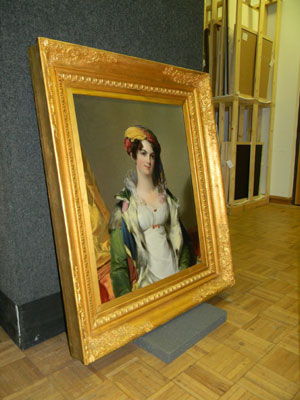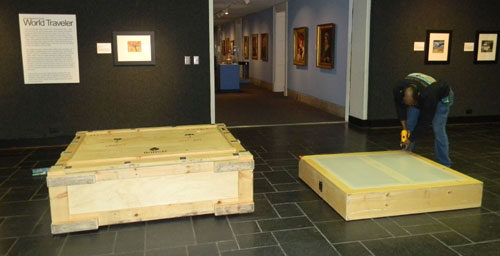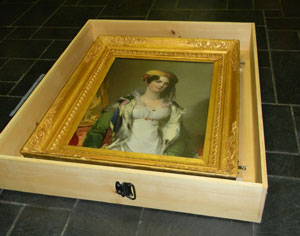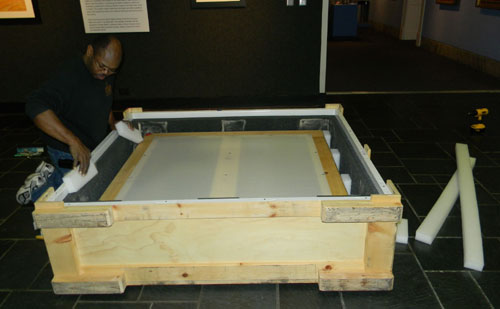
How do you prepare for upcoming travel? Perhaps you check the weather for your destination and reconfirm transit arrangements. You might make sure luggage is in suitable condition and your accommodations are up to par. Maybe you review your travel wardrobe or purchase new travel clothing. Interestingly, preparing artwork to travel is not all that different. As Director of Collections Administration, I think a lot about how artwork is going to travel out of the museum, out of the state, or even out of the country. One of my responsibilities is to act as travel agent and personal assistant to artwork in the Gibbes collection. I make sure each piece is in good physical condition to travel; clear itineraries with Gibbes curators who may need particular works for upcoming exhibitions; make sure each piece has a travel container; and oversee all transit arrangements.
The outgoing loan of Mrs. Robert Gilmor, Jr. (Sarah Reeve Ladson) by Thomas Sully (American, 1783–1872) is a good example of this process. As you have probably heard (or seen in the January issue of Charleston Magazine), this lovely painting—along with five other pieces from our collection—is preparing for a whirlwind trip to New York City where she will be featured in the loan exhibition at the Winter Antiques Show. The exhibition, Grandeur Preserved: Masterworks Presented by Historic Charleston Foundation, will highlight more than fifty objects selected from Charleston’s leading cultural institutions as well as private collections. Mrs. Gilmor will be a star in this show, and I (the personal assistant and travel agent) have been preparing her trip for many months.
Let me share some details of Mrs. Gilmor’s travel itinerary and preparations. Historic Charleston Foundation invited Mrs. Gilmor to participate in this exhibition over a year ago. Thankfully that was plenty of time to clear her social schedule in terms of upcoming exhibitions at the Gibbes. In addition to the “invitation,” or outgoing loan request, we received a facility report for the exhibition destination which contains important details about the loan venue’s security, lighting, and climate control, as well as information about how our painting would be installed and who would install it. These documents had to be approved by the Collections Committee and Board of Directors of the Gibbes Museum of Art. We also approved the details of her travel arrangements. Thomas Sully painted Mrs. Gilmor in 1823. She is 188 years old and prefers to travel in style. Fortunately, she already owns a custom crate which keeps her safe and comfortable during transit. Mrs. Gilmor traveled to China in this crate several years ago and enjoyed the security it provided.

Another part of the outgoing loan process is scheduling a thorough conservation assessment. Think of this as the physical check-up sometimes needed prior to strenuous travel. Before Mrs. Gilmor was approved for loan, I reviewed her condition with an art conservator to make sure that the paint surface was stable and her frame was solid with all gilding intact. Any needed repairs must be scheduled well in advance of the actual travel dates—timing is everything when it comes to outgoing loan preparation. Fortunately, Mrs. Gilmor is in wonderful condition. She had some work done (shhhh) before the afore-mentioned trip to China and is in great shape to travel to New York City.

While Mrs. Gilmor required no grooming for this particular trip, I did prepare a detailed condition report. Condition reports contain images and a complete description of any flaws or vulnerable areas that exist on a work before it is released for travel. Condition reports are very important and must be reviewed when loans reach their destinations. While only the most qualified museum professionals handle and transport loans, it’s always good to have written documentation of a painting’s pre-loan condition… just in case.

Now here we are, just days away from Mrs. Gilmor’s trip to New York City. I have been in touch with the shippers and confirmed her transit itinerary. Her accommodations at the Park Avenue Armory are ready and I am in possession of the very detailed installation plan. She is secure in her crate and ready to go. I will be in New York to greet her upon arrival and make sure she is comfortable in her temporary surroundings. As a personal assistant to artwork, sometimes when you request an outgoing loan from the Gibbes… you get me too!
See you in New York!
—Zinnia Willits, Director of Collections Administration, Gibbes Museum of Art
Other works of art traveling to New York City from the Gibbes Museum’s collection include:
View of Mulberry, House and Street, ca. 1805, by Thomas Coram (American, 1756 – 1811). Oil on paper; 4 1/16 x 6 11/16 inches. Museum Purchase (1968.018.0001)
Eliza Izard (Mrs. Thomas Pinckney, Jr.), 1801, by Edward Greene Malbone (American, 1777 – 1872). Watercolor on ivory; 2 7/8 x 2 3/8 inches. Museum Purchase (1939.004.0004)
Colonel Thomas Pinckney, Jr., 1801, by Edward Greene Malbone (American, 1777 – 1872). Watercolor on ivory; 3 x 2 3/8 inches. Museum Purchase (1939.004.0003)
Mrs. Arthur Middleton (Alicia Hopton Russell Middleton), 1836, by Andrew Robertson (Scottish, 1777 – 1845). Watercolor on ivory; 3 5/8 x 2 3/4 inches. Gift of Alicia Hopton Middleton (1937.005.0002)
Charlotte Helen Middleton and her enslaved nurse, Lydia, 1852, by George Smith Cook (American, 1819 – 1902). Ambrotype. Gift of Alicia Hopton Middleton (1937.005.0010)
Published January 14, 2011

